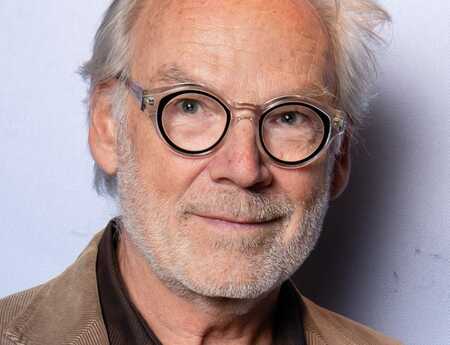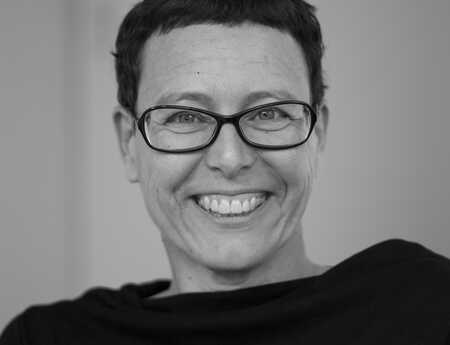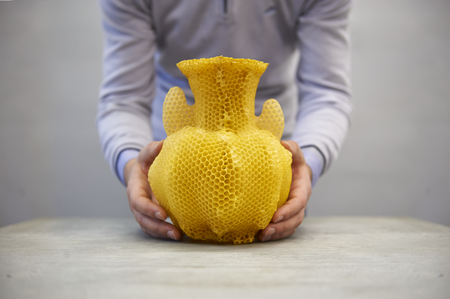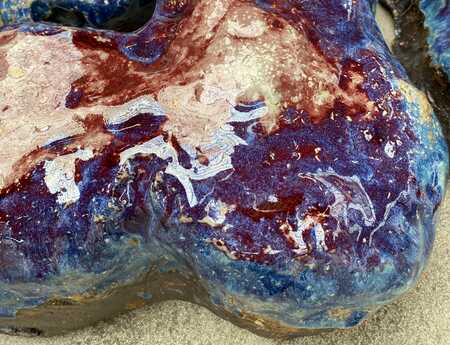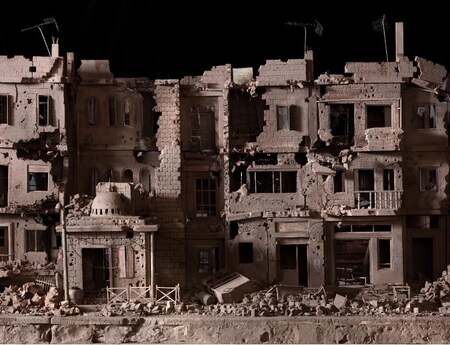Tomáš Gabzdil Libertíny: Gemeinsam mit Bienen gestalten
Kunstschaffende verstehen es meisterhaft, zu visualisieren, zu imaginieren und zu überzeugen. Mit ihrer Arbeit erzählen sie Geschichten, die einen bleibenden Eindruck hinterlassen. Wenn es um das Thema Klima geht, verfolgen sie nicht unbedingt einen wissenschaftlichen Ansatz; zuweilen entspringt ihre Arbeit einem Interesse an der Schönheit und Intelligenz der Natur.
Für Tomas Libertíny (Slowakei, 1979) bildet die Beziehung zwischen Mensch und Natur eine ständige Quelle der Inspiration. Mit seiner Arbeit zeigt er uns, dass wir Teil der Natur sind. Durch ein sorgfältiges Studium der Natur und die Anpassung unseres Verhaltens, unseres Konsums, können wir einen Teil zum Erhalt unseres Planeten beitragen.
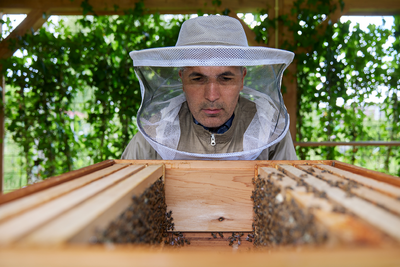
Wir treffen uns in Libertínys Bienenfarm auf dem Gelände der Villa Lakeside, in der sich auch das Unternehmen des Investors und Kunstsammlers Ali Keles befindet. Gemeinsam mit Keles gründete Libertíny vor drei Jahren seine Bienenfarm. Fünf Bienenstöcke stehen fein säuberlich gruppiert unter einem Vordach am Rand des Wassers. Dort findet die Kollaboration zwischen Künstler und Bienen statt; die Bienen vervollständigen die Formen, die Libertíny in den Bienenstöcken platziert. Aus dieser Kooperation entstehen faszinierende Objekte, die in der neuen Sparte „Artistic Matters“ auf der Art Rotterdam 2024 präsentiert wurden und vor Kurzem im Israel Museum in Jerusalem zu sehen waren.
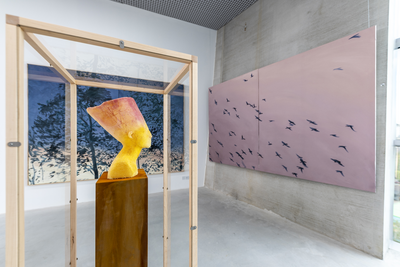
Erzählen Sie mir von diesen Bienenstöcken. Wie funktionieren sie?
„Wir haben fünf Bienenstöcke. Zu Beginn des Frühlings herrscht dort rege Betriebsamkeit. Im größten Bienenstock werden die Bienen dazu eingeladen, an den Strukturen zu arbeiten, die ich darin platziert habe. Ich habe ein System entwickelt, mit dem ich den Arbeitsfortschritt kontrollieren kann, ohne den Bienenstock öffnen zu müssen. Es gibt Sichtfenster aus Glas, durch die ich sehen kann, wie die Bienen vorankommen. Auf diese Weise behandle ich die Bienen mit dem nötigen Respekt und mache sie nicht zu nervös.“
Sie sind nicht der Imker, es gibt eine andere Person, die sich um die Bienen kümmert. Warum ist das so?
„Ich wollte die Bienenzucht von der Erstellung des Kunstwerks getrennt halten. Als Künstler will ich die Grenzen eines Verfahrens ausloten. Aber als ein Naturfreund und jemand, der die Natur respektiert, wollte ich gewisse Grenzen nicht überschreiten, an die mich mein Ehrgeiz hätte bringen können. Deshalb lasse ich mich vom Imker beraten und er sagt mir, was getan werden muss, um die Gesundheit und Qualität des Bienenvolkes zu erhalten. Seit siebzehn Jahren arbeite ich schon mit Bienenzüchtern zusammen. Aber seit fünf Jahren habe ich nun mein eigenes Bienenvolk hier in Rotterdam-Overschie.“
Was machen Sie mit dem Honig, den die Bienen produzieren?
„Wir konzentrieren uns nicht wirklich auf den Honig, wie andere Imker. Den größten Teil des Honigs überlassen wir den Bienen, und wenn es einen Überschuss gibt, dann erntet der Imker ihn.“
Etwa zehn Minuten später gehen wir zu den Bienenstöcken, wo Libertíny eine runde Platte von der Rückseite eines hohen Bienenstocks hebt, damit wir hineinschauen können. Wir sehen zwei Formen, auf denen die Bienen landen und mit viel Geduld Honigwaben bauen. In den vier anderen Bienenstöcken ist noch wenig Aktivität zu sehen. In ihnen werden gerade neue Königinnen angesiedelt, damit diese dann ein neues Bienenvolk gründen. Bienen leben etwa fünf bis sechs Wochen, die Königin lebt fünf bis sechs Jahre.
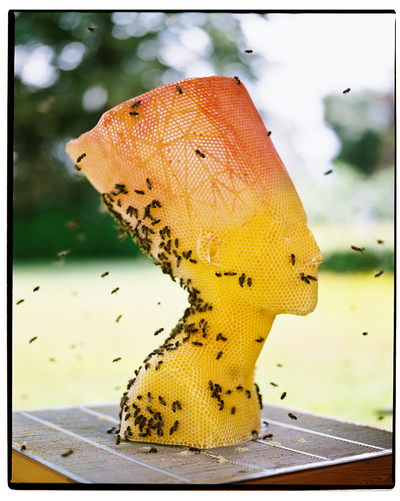
Wie werden die Ausgangsformen hergestellt?
„Die Statue der Nofretete, die ich diesen Sommer im Kunstmuseum Den Haag gezeigt habe, war eine Art von Durchbruch. Der Rahmen ist so etwas wie ein Gitterwerk, ein Gerüst, um das herum die Bienen ihre Zellen bauen können, die dann zu einer Honigwabe werden. Der Rahmen ist von mir so entworfen worden, weil ich wusste, welche Form sie mögen. Sie lieben es, in den Bäumen und Sträuchern mit diesen ineinander verschlungenen Aststrukturen zu hängen. Das ist genau so, wie ich die Form entworfen habe. Als reine gedruckte 3D-Form sieht Nofretete aus wie die Zweige eines Busches.“
Sie verwenden häufig Vasenformen für Ihre Arbeiten, aber es finden sich auch viele historische Figuren in Ihrem Werk. Nimmt die Geschichte einen wichtigen Platz in der Entwicklung Ihrer Arbeiten ein?
„Auf jeden Fall. Ich habe großen Respekt vor der Geschichte und der Mythologie. Ich nutze sie als Quelle und versuche, diese Geschichten zu interpretieren, historische Figuren ins 21. Jahrhundert zu holen und ihnen eine neue Bedeutung zu geben. Im Israel Museum hatte ich eine Ausstellung mit dem Titel Crafted by Bees (Von Bienen gefertigt). Dort habe ich ein Porträt von Hadrian gezeigt. In der archäologischen Abteilung des Museums gibt es eine riesige Bronzeplastik von ihm. In der Antike wurden Bronzeplastiken mit Bienenwachs hergestellt. Das Wachs wurde weggeschmolzen, und dann hat man sie in Bronze gegossen. Also habe ich mit den Bienen eine von Bienen erschaffene künstlerische Interpretation der ursprünglich aus Wachs erstellten Bronzen gemacht. Ich habe zwei Versionen von Hadrian gestaltet: eine realistischere und eine abstraktere.“
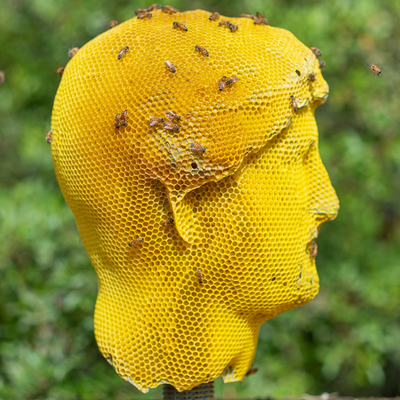
Sie sprechen auf Ihrer Website über die Beziehung zwischen Mensch und Natur. Finden Sie, dass dies eine positive Beziehung ist?
„Die Natur ist weder gut noch schlecht. Wir romantisieren die Tatsache, dass wir eins mit der Natur sein müssen, und kritisieren uns selbst, wenn wir uns anders verhalten. Wir sind nur ein Teil der Natur, ein individueller Organismus, wie viele andere Organismen und Arten auch, ohne Bestimmung oder Absicht.“
Glauben Sie nicht, dass der Mensch das Gleichgewicht in der Natur gestört hat?
„Natürlich stimmt das, aber ich möchte das Ganze auf eine positive Art und Weise betrachten. Ich lasse mich von den guten und schlechten Dingen in der Natur inspirieren. Abgesehen von den unglaublich negativen Auswirkungen, die wir auf die Erde haben, sind wir die einzige Spezies auf unserem Planeten, die die von uns verursachten Schäden rückwirkend wieder beheben kann. Ich habe die Hoffnung, dass wir die Dinge zum Besseren wenden werden.“
Konnten Sie selbst feststellen, dass die Bienenpopulationen rückläufig sind?
„Auf meiner Bienenfarm passiert das normalerweise nicht, weil wir mit einem professionellen Imker zusammenarbeiten. Aber manchmal kommt es vor, dass ein Bienenvolk stirbt. Von fünf Bienenvölkern überlebt eines den Winter nicht. Aber ich habe von anderen Imkern gehört, dass immer mehr Bienenvölker sterben. Noch ist es nicht so schlimm wie in China. Vor etwa zehn Jahren waren in einer chinesischen Region die negativen Auswirkungen der Umweltverschmutzung auf den Lebensraum der Bienen so enorm, dass fast alle Bienen verloren waren. Also mussten die Menschen ihre Apfelbäume selbst manuell bestäuben. Ein unglaubliches Mad-Max-Szenario.“
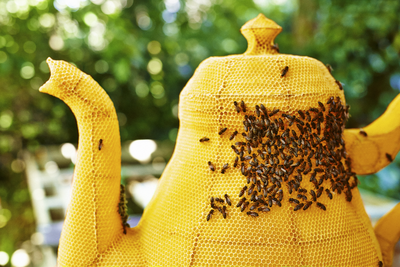
Nicht nur die Zahl der Bienen, sondern auch die gesamte Zahl an Insekten ist stark zurückgegangen. Einer aktuellen Studie zufolge ist die Zahl der Fluginsekten in den letzten 27 Jahren um 76 Prozent zurückgegangen. Kann man dagegen etwas tun?
„Heutzutage gibt es neben den Bienen immer weniger andere Insekten. Die Biene ist bei den Menschen immer noch sehr beliebt. Wenn wir aber über die Bestäubung sprechen, sind die Bienen nur ein kleiner Teil davon. Es gibt so viele andere Insekten, die für zahlreiche andere Arten von Pflanzen notwendig sind. Und die Zahl dieser Insekten ist tatsächlich stark rückläufig. Aus diesem Grund wird die Artenvielfalt der Pflanzenwelt sehr wahrscheinlich zurückgehen, und die Rolle der Bienen wird immer wichtiger werden, wenn andere Insekten verschwinden. Eine Lösung wäre, das Gras in den Städten nicht ständig zu mähen, damit bestimmten Insekten ein Lebensraum zur Reproduktion zur Verfügung steht. Ich bin für eine gut organisierte Wildnis in den Städten. Und natürlich können wir alle unseren eigenen kleinen Beitrag dazu leisten. Ich selbst habe zum Beispiel kein Auto. Wenn ich wirklich eines brauche, miete ich es.“
True Colors, AkzoNobel Art Foundation im Kunstmuseum Den Haag
1. Juni 2024 bis 29. September 2024

